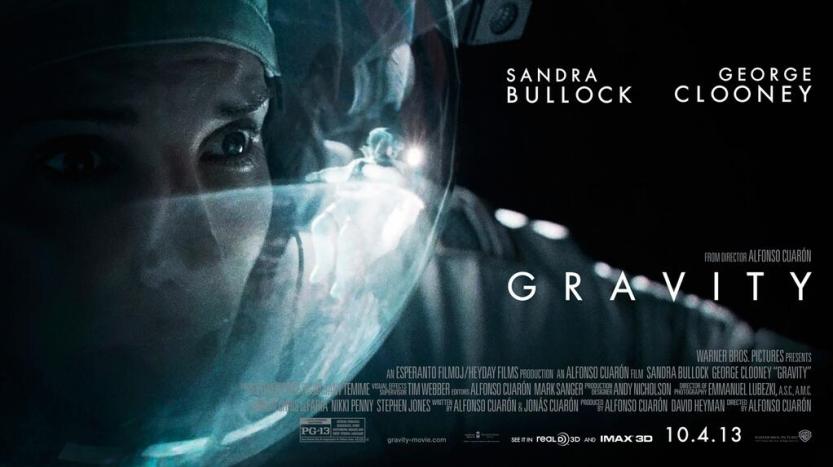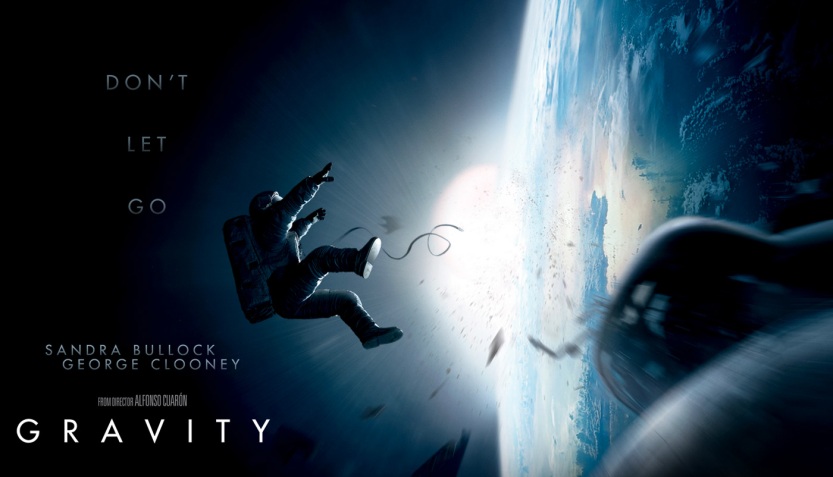Alfonso Cuarón has composed an incredible humanistic near-future film with Gravity, his second foray into the field of science fiction after Children of Men. It’s one of the most public expressions of space debris issues I have yet to witness. Let’s take a moment to examine the story, the characters, and most importantly the themes, politics, and science, as well as some commonalities with my previous work, “Tethered.” Recently published in the July/August 2013 issue of Analog Magazine of Science Fiction and Fact and a Semi-Finalist in the 2011 L. Ron Hubbard Writers of the Future Contest, “Tethered” tells the story of two astronauts employed by a powerful corporation to clear Earth orbit after a series of near-future diplomatic fall-outs have clogged Earth orbit with debris, rendering outer space an “impassable frontier.” The two are caught in the midst of a corporate and political skirmish involving China, their employer, a South Asian oil pipeline, and the U.N. Security Council.
Learn about the science, politics, and contemporary relevance of “Tethered” and purchase ”Tethered” from Analog. Read about other works on the Publications page.
Space Debris: Despite the loopholes in science (see below), there is quite a lot the movie gets right, and I applaud the director for getting to the core of the aerospace issue (at the end of the day, it’s everyone’s problem) most at stake today — space debris. He not only gets right the minutiae of handling floating objects and orbital momentum, but, most importantly, he nails it on the head with space debris. The event which begins the disaster and tension of the film is a Kessler Syndrome-related incident: The Russians launch a kinetic kill vehicle at its own dead (probably spy) satellite, which generates a chain reaction of debris, knocking out almost all telecommunications satellites, resulting in the collision which casts the protagonists into chaos. I wish the film had addressed probable entities which might have gotten involved (such as the Space Based Surveillance System or US kinetic kill vehicles), but ultimately, launching the problem of space debris into the public consciousness — through the power of storytelling and human connection — is undoubtedly Gravity‘s greatest achievement.
There are many commonalities with my previous work, “Tethered,” which imagines a slightly farther along and much bleaker future, in which events such as the one in Gravity become commonplace within the next few decades, eventually rendering orbital space flooded with debris, the “final frontier” now an impassible one. It aims to recognize the dangers of politicized space travel — that we should pursue the progress of science unhindered from either pure military or capitalistic subtexts, that we should travel into the final frontier for the sake of scientific discovery and the preservation and betterment of our species’ peaceful future. It’s incredibly gratifying to see Cuarón picking up on an issue, namely space debris (even if Gravity is less political than “Tethered”), which has remained far too low under the radar of the public sphere since Donald Kessler first warned of the impending dangers of space debris in 1978. We need to not only recognize the problems of the Kessler Syndrome, but we need to also seek to alleviate them in a way respectful and mutual among many nations, corporations, and cultures.
Launching the problem of space debris into the public consciousness — through the power of storytelling and human connection — is Gravity‘s greatest achievement.
Read more about the science, politics, and contemporary relevance of “Tethered” by clicking here.
IEEE Spectrum covers space debris in Gravity here.
The Hard Science: The film gets a lot right, but slips up frequently, probably for dramatic effect — which in some sense is acceptable for the sake of keeping audience’s entranced. Still, I’ll name a few — it’s important to remain aware. The Hubble Telescope and the International Space Station are close enough to travel between via an astronaut’s jet-pack when even a shuttle would risk running out of fuel in that distance. Similarly, the Chinese Space Station (CSS, not scheduled for completion until 2020, suggesting the near-future setting of the story) is close enough to the ISS to travel between the two using only the landing fuel in a Soyuz Rocket. Furthermore, it takes protagonist Ryan Stone only a few minutes to get into her suit and spacewalk (EVA), when the EVA preparation process usually takes 24 hours in a cabin with lowered pressure and higher oxygen, followed by an hour “pre-breathing” 100% oxygen to prep for the suit conditions. Without this, astronauts risk the “bends.” Given the existence of the CSS, suggesting a near future where other technologies may be able to reduce the length of EVA prep, this may be a possibility, but Cuarón’s technology seems mostly set in the present day.
Perhaps most glaring is Stone’s inability to keep her calm and conduct herself professionally, intelligently. In part, the film seems to be an exploration of her regaining strength and confidence — but in the first place NASA is extremely selective with its astronauts. They are highly trained. They will certainly panic in disasters, but they can keep their cool and think their way through problems without hyperventilating. Recruiting astronauts who aren’t liable to meet these standards poses a significant risk to many lives and boatloads of government funds.
Check out Neil deGrasse Tyson on his A-game, tweeting Gravity into oblivion.
Astronaut Dr. Michael Massimino’s take on Gravity in the NYT.
Story, Character, Themes: With all the above said, Cuarón brilliantly imagines both the beauty and minutiae of life in space, playing out the very human consequences of the Kessler Syndrome. It’s certainly more charactered than Stanley Kubrick’s classic 2001: A Space Odyssey, and closer to reality, but it still lacks some human element in a story dominated by visuals and thematic motifs more than plot or character. That’s not necessarily a bad thing — as with Children of Men, Cuarón has succeeded in expressing his imagination in a way different from the average fare. It’s a spectacular film, one of the best of the year, but still falls slightly short of hype (currently 98% on Rotten Tomatoes). Nevertheless, there is much to be said for Cuarón’s ability to manipulate themes — early in the film, a protagonist (I remain vague to avoid spoilers) is shown with imagery akin to a fetus and umbilical cord, a motif which returns in the film’s magnificent conclusion, which uses the symbolism of Earth — water, clay, greenery — and “baby steps” to celebrate and symbolize the transformation of a character from one trying phase of life into another, a rebirth. Cuarón succeeds in demonstrating the cosmos as a macrocosm for the individual, and the individual as a microcosm for the cosmos.


I have a question regarding the security of the space stations. In the movie, Ms.Stone just opens and enters the Chinese Space Station. Is this correct? Will the stations remain unlocked so that anyone from outside can open and enter them at will?
Dear Sai,
Good question. I am not certain as to whether anyone from the outside can open and enter them at will. Keep in mind that the Chinese Space Station has yet to be built. This is a question I asked myself throughout the film. Given the high implausibility – at least in the present day – of situations which would involve an “unauthorized” astronaut to enter a given station, I don’t imagine that the airlocks are in fact locked. Again this is mere speculation.
However, your question also injects an interesting new angle on the question of security in space. Space stations – at least the International Space Station – are viewed as, by definition, international and outside the boundaries of states and corporations. But given China’s rising aerospace program and the increasing corporatization and privatization of space, corporations, governments, and most importantly scientists, citizens, and consumers – the general masses – will have to define the boundaries of “property” and space in orbit and beyond. The higher, though perhaps utopian, ground is to take advantage of this newfound situation to forge forward under a set of political and economic structures which do away with the need for boundaries in the first place, a la Gene Roddenberry. But unfortunately thus far our explorations into space have predominantly been driven by political, military, and most recently economic motives above a scientific or social drive, and the trajectory seems to only escalate this problem.
As Carl Sagan remarked in 1979’s Science Digest, “Scientists constantly get clobbered with the idea that we spent 27 billion dollars on the Apollo programs, and are asked ‘What more do you want?’ We didn’t spend it; it was done for political reasons… Apollo was a response to the Bay of Pigs fiasco and to the successful orbital flight of Yuri Gagarin. President Kennedy’s objective was not to find out the origin of the moon by the end of the decade; rather it was to put a man on the moon and bring him back, and we did that.”
Hopefully the legal challenges of space travel will provide us an opportunity to rethink the way we govern not only the world above our atmosphere but also the world beneath it.
Apologies for the tangential response — it’s interesting stuff!